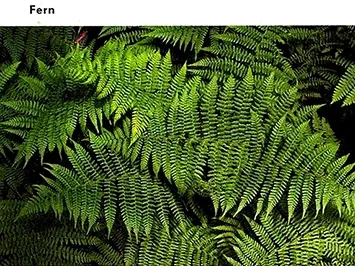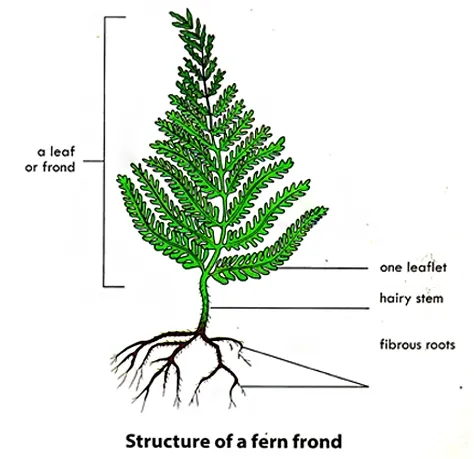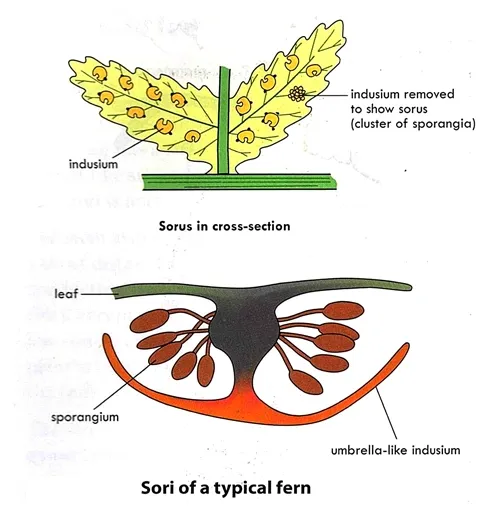Fern Plants: Structure, Types, and Life Cycle Explained
Objectives
Structure, Types, and Life Cycle of Fern Plants
Kingdom: Plantae
Division: Filicinophyta
Habitats of Fern Plants
They grow mostly in moist habitat on land or trunks of trees and palm trees.
Types and Examples of Ferns
Ferns are a diverse group of plants with thousands of species found worldwide. Here are some of the major types of ferns, categorized by their distinctive characteristics and habitats:
1. Adiantum (Maidenhair Ferns)
- Characteristics: Delicate, fan-shaped fronds with black stems.
- Habitat: Commonly found in moist, shaded areas.
- Notable Species: Adiantum capillus-veneris (Venus Maidenhair Fern).
- Characteristics: Fronds range from simple to highly divided, often with a glossy appearance.
- Habitat: Found in a variety of environments, from tropical rainforests to temperate regions.
- Notable Species: Asplenium nidus (Bird’s Nest Fern).
- Characteristics: Fronds resemble holly leaves, with glossy, dark green leaflets.
- Habitat: Typically found in shaded, woodland areas.
- Notable Species: Cyrtomium falcatum (Japanese Holly Fern).
- Characteristics: Large, arching fronds that form dense clumps.
- Habitat: Common in temperate forests and woodlands.
- Notable Species: Dryopteris filix-mas (Male Fern).
- Characteristics: Fronds are often leathery and evergreen, with a symmetrical appearance.
- Habitat: Found in a range of environments, from woodlands to rocky slopes.
- Notable Species: Polystichum acrostichoides (Christmas Fern).
- Characteristics: Large, triangular fronds that can reach several feet in height.
- Habitat: Often found in open fields and disturbed areas.
- Notable Species: Pteridium aquilinum (Common Bracken).
- Characteristics: Fronds are often pinnate and can be either evergreen or deciduous.
- Habitat: Commonly found in wet, marshy areas.
- Notable Species: Blechnum spicant (Deer Fern).
- Characteristics: Fronds are long, arching, and sword-like in shape.
- Habitat: Thrives in tropical and subtropical regions.
- Notable Species: Nephrolepis exaltata (Boston Fern).
- Characteristics: Fronds are large and divided, with a striking, regal appearance.
- Habitat: Found in wet, swampy areas and along stream banks.
- Notable Species: Osmunda regalis (Royal Fern).
- Characteristics: Epiphytic ferns with fronds that resemble stag antlers.
- Habitat: Grows on trees in tropical and subtropical forests.
- Notable Species: Platycerium bifurcatum (Common Staghorn Fern).
- Characteristics: Tall, feather-like fronds that resemble ostrich plumes.
- Habitat: Common in moist, shady forests and along riverbanks.
- Notable Species: Matteuccia struthiopteris (Ostrich Fern).
- Characteristics: Fronds are delicate and finely divided, often with a lacy appearance.
- Habitat: Found in woodlands and shaded garden areas.
- Notable Species: Athyrium filix-femina (Lady Fern).
Structural Features of Fern Plant
Fern has an underground stem called rhizome; thin adventitious roots, which absorb water and mineral salts and prominent leaves, called fronds. Fronds emerge from the rhizome as a coiled structure which gradually unrolls as growth proceeds. Each frond is pinnately compound, made up of several leaflets (pinnae). The leaf lamina is covered with shiny cuticle which reduce the rate transpiration.
Asexual reproductive structure (Sporangia, containing spores) develops on the under-surface of the mature leaflets. Cluster of sporangia called sori, are found at the leaflet margins. A protective structure called an indusium covers each sorus (plural: sori). The stem, roots and leaves have well developed vascular tissue.
Life cycle of Fern Plant
The spores develop in the sporangia, are released and dispersed when the sporangia burst on ripening. Under favorable condition of moisture and temperature, each spore germinates into a small, flat, heart-shaped photosynthetic structure called prothallus (i.e., the gametophyte). The prothallus is anchored to land by unicellular rhizoids. A matured prothallus bears the antheridia, the male sex organs and archegonia, the female sex organs on its under-surface. The antheridia produce bi-flagellate sperms called antherozoids. Each archegonium produces a single egg called oosphere. The sperm swims in a film of water on the surface of the prothallus to fuse with the egg to form a zygote. The zygote grows into an embryo and eventually develops into fern plant, the sporophytes. The gametophytes tissue decays and the sporophytes live independently.
The life cycle of the fern plant follows the pattern of alternation of generations. The gametophyte of the fern plant is small and insignificant compared to the sporophyte. Therefore, the sporophyte generation is dominant. The gametophyte and sporophyte are independent.
For more detailed information on ferns, their structure, and their life cycle, visit Britannica on Ferns
Functions of Ferns
Ferns play several important roles in their ecosystems and have various functions, both ecologically and economically. Here are some of the key functions of ferns:
Ecological Functions
Soil Formation and Stabilization: Ferns contribute to soil formation by breaking down rocks and organic matter through their root systems. Their roots also help stabilize soil and prevent erosion, particularly in forested and mountainous regions.
Habitat and Food Source: Ferns provide habitat and food for a variety of organisms. Many insects, birds, and small mammals rely on ferns for shelter and sustenance. Some ferns are also host plants for certain butterfly species.
Water Regulation: Ferns play a role in the water cycle by absorbing and retaining moisture. Their dense root systems and foliage help maintain humidity levels in their immediate environment, which can benefit other plants and animals.
Carbon Sequestration: Like all green plants, ferns perform photosynthesis, converting carbon dioxide into oxygen and organic matter. This process helps reduce atmospheric carbon dioxide levels, contributing to climate regulation.
Economic and Cultural Functions
Horticulture and Landscaping: Many fern species are cultivated for ornamental purposes due to their attractive foliage. They are commonly used in gardens, landscapes, and indoor plantings.
Traditional Medicine: Some ferns have been used in traditional medicine for their purported therapeutic properties. For example, the rhizomes of certain fern species are used to treat various ailments in some cultures.
Food and Fiber: In some regions, young fern fronds (known as fiddleheads) are harvested and consumed as a vegetable. Additionally, certain fern species are used to produce fiber for weaving and other crafts.
Environmental Indicators: Ferns can act as bioindicators, providing insights into the health of an ecosystem. Changes in fern populations can signal shifts in environmental conditions, such as soil pH, moisture levels, and pollution.
Conclusion
Ferns are remarkable plants with a sophisticated structure and a unique life cycle that alternates between the sporophyte and gametophyte generations. Understanding these aspects of fern biology not only highlights their evolutionary success but also their ecological importance.
For further reading, explore these reputable resources:





